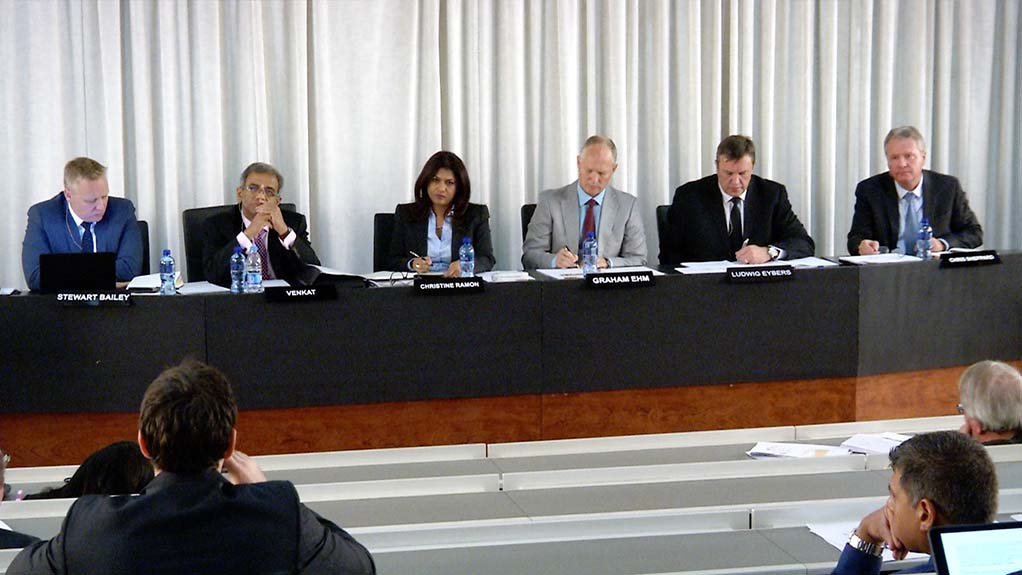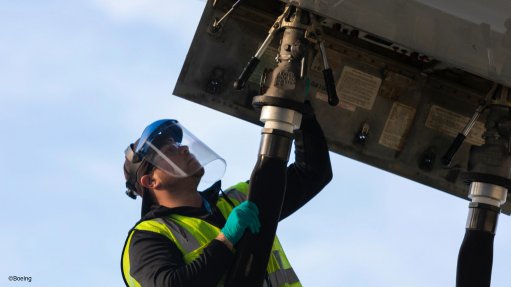Vibrant future planned for remaining South African mines – AngloGold


AngloGold Ashanti COO Chris Sheppard provides operational update to Mining Weekly’s Martin Creamer. Video: Darlene Creamer. Video Editing: Lionel da Silva
The AngloGold Ashanti team
Photo by Creamer Media
JOHANNESBURG (miningweekly.com) – The removal of loss-making ounces from old mines will result in a vibrant and sustaining future for the remaining long-life operations in AngloGold Ashanti's South African region, which is at the receiving end of $200-million worth of capital expenditure (capex).
In outlining this to Creamer Media’s Mining Weekly Online at a media round table, AngloGold CEO Srinivasan Venkatakrishnan said that by eliminating losses at Kopanang, TauTona and Savuka, the company is securing a far-reaching future for Mponeng, Moab Khotsong and Mine Waste Solutions.
AngloGold is consulting with employees on placing the 59-year-old Savuka mine and the 36-year-old Kopanang mine on care and maintenance, and evaluating the integration of the 60-year-old TauTona mine into neighbouring Mponeng, which is being set up as a new, lower-cost mine, with the company redefining what is possible at ultra-depth.
While decisive action is taken to stem losses, $82-million capex – $6-million more than that last year's amount – is being ploughed into Mponeng alone, where the production benefits of the Phase 1 extension are already beginning to come through.
Mponeng remains the strongest asset in the portfolio, with Moab Khotsong a close second.
Good cash generator Moab Khotsong and the surface operations of Mine Waste Solutions will require investment beyond the medium term.
“When you take into account the South African region as a whole, you’re starting to see benefits come through,” Venkatakrishnan told Mining Weekly Online.
The Mponeng deepening project involves extending development of the world’s deepest mine to 123 level and 126 level.
In this regard, AngloGold Ashanti is narrowing down its technology focus to where it can be applied at Mponeng.
AngloGold COO Chris Sheppard said success with ultrahigh-strength backfill was being used to develop high-strength backfill for conventional mining, the outcome of which would be either to reduce seismic potency or increase extraction rates, both of which would be beneficial to production going forward.
AngloGold’s South Africa region recorded a 20% jump in production in the three months to June 30, when rand denominated costs fell by 10%.
In the half-year, the South Africa region produced 435 000 oz of gold, which represents 25% of AngloGold’s total production of 1.7-million ounces in the first six months of 2017.
Moab Khotsong production rose 3% on improved throughput and face time, and production improved at Mine Waste Solutions’ surface operations on higher grades across the sulphur pay dam.
Recording losses were Kopanang, with costs of $1 472/oz, and TauTona, with costs of $1 639/oz. The Savuka section of TauTona continues to operate at lower volume.
The all-in sustaining cost for the South African operations was $1 259/oz, compared with $958/oz in the same period in 2016, with total cash costs being hit by lower output, adverse currency movement, labour, consumables and electricity inflationary pressures and an unfavourable by-product contribution.
While 8 500 roles across the 28 000-employee South African business are coming under intense scrutiny, the Johannesburg Stock Exchange- and New York Stock Exchange-listed company underscored its determination to limit job loss to an absolute minimum as its long-term South African mines are repositioned for a sustainable future.
“Job loss is always a last resort, particularly in the context of elevated unemployment in South Africa,” Sheppard told investors, analysts and journalists at the company’s presentation of an adjusted headline loss of $93-million for the half-year, which took in a retrenchment provision of $47-million and a silicosis provision of $46-million.
Consideration has been given to integrating TauTona into the long-life Mponeng mine, as was done successfully on a previous occasion with the integration of Savuka into TauTona some years back.
Unfortunately, at this stage it appears that there is limited potential to replicate that model on a sustainable basis.
AngloGold has provided plans, forecasts, opinions and assumptions to labour unions and the Department of Mineral Resources for scrutiny and expert review.
The mandatory consultation process is progressing under Section 189 of the Labour Relations Act to mitigate the loss of jobs.
The company anticipates reaching a conclusion in the second half of this year and in parallel with these consultations, a voluntary severance programme has been opened up to all employees.
Depending on the timing and outcome of the process, amendments will be made to outlook and future costs and production profiles will be made.
The Savuka section in question has already been extended ten years beyond its natural life and Kopanang produced its first gold in 1981.
The mines earmarked for care and maintenance have for some time faced ore-reserve depletion, increasing depth, growing distance from central infrastructure, declining production profiles and cost escalations that have continued to outpace both inflation and a subdued gold price.
AngloGold has 17 gold mines in nine countries, as well as exploration programmes in both the established and new gold-producing regions of the world.
The more immediate of its key long-term projects is the Mponeng Phase 1 project, which together with Guinea's Siguiri gold mine and the Democratic Republic of Congo's Kibali joint venture, is giving the company line of sight to a better portfolio, backed by continued exploration successes.
Full ramp-up at Mponeng is scheduled to take place through this year and next year, with the so-called above-120-level 'old mine' reaching the end of its ore-reserve position within the next four years.
In the next three to four years, the entire production load of Mponeng will be generated on its Phase 1 horizon.
What was called a Phase 2 project is being restudied to find the most optimal way of investing into the promising orebody.
Rather than using large capital investments, the company is continuing to pursue lasting operational improvement through innovation.
Apart from Mponeng, the balance of AngloGold’s South African underground portfolio has been suffering from a lack of mineable face length, which has the capability of increasing volume and offering the flexibility that is needed for consistent performance.
Advancing lower-capital, quicker-payback projects on a self-funded basis has become the norm.
The company has an attributable ore reserve of 50.1-million ounces of gold and an attributable mineral resource of 214.7-million ounces.
Comments
Announcements
What's On
Subscribe to improve your user experience...
Option 1 (equivalent of R125 a month):
Receive a weekly copy of Creamer Media's Engineering News & Mining Weekly magazine
(print copy for those in South Africa and e-magazine for those outside of South Africa)
Receive daily email newsletters
Access to full search results
Access archive of magazine back copies
Access to Projects in Progress
Access to ONE Research Report of your choice in PDF format
Option 2 (equivalent of R375 a month):
All benefits from Option 1
PLUS
Access to Creamer Media's Research Channel Africa for ALL Research Reports, in PDF format, on various industrial and mining sectors
including Electricity; Water; Energy Transition; Hydrogen; Roads, Rail and Ports; Coal; Gold; Platinum; Battery Metals; etc.
Already a subscriber?
Forgotten your password?
Receive weekly copy of Creamer Media's Engineering News & Mining Weekly magazine (print copy for those in South Africa and e-magazine for those outside of South Africa)
➕
Recieve daily email newsletters
➕
Access to full search results
➕
Access archive of magazine back copies
➕
Access to Projects in Progress
➕
Access to ONE Research Report of your choice in PDF format
RESEARCH CHANNEL AFRICA
R4500 (equivalent of R375 a month)
SUBSCRIBEAll benefits from Option 1
➕
Access to Creamer Media's Research Channel Africa for ALL Research Reports on various industrial and mining sectors, in PDF format, including on:
Electricity
➕
Water
➕
Energy Transition
➕
Hydrogen
➕
Roads, Rail and Ports
➕
Coal
➕
Gold
➕
Platinum
➕
Battery Metals
➕
etc.
Receive all benefits from Option 1 or Option 2 delivered to numerous people at your company
➕
Multiple User names and Passwords for simultaneous log-ins
➕
Intranet integration access to all in your organisation




















